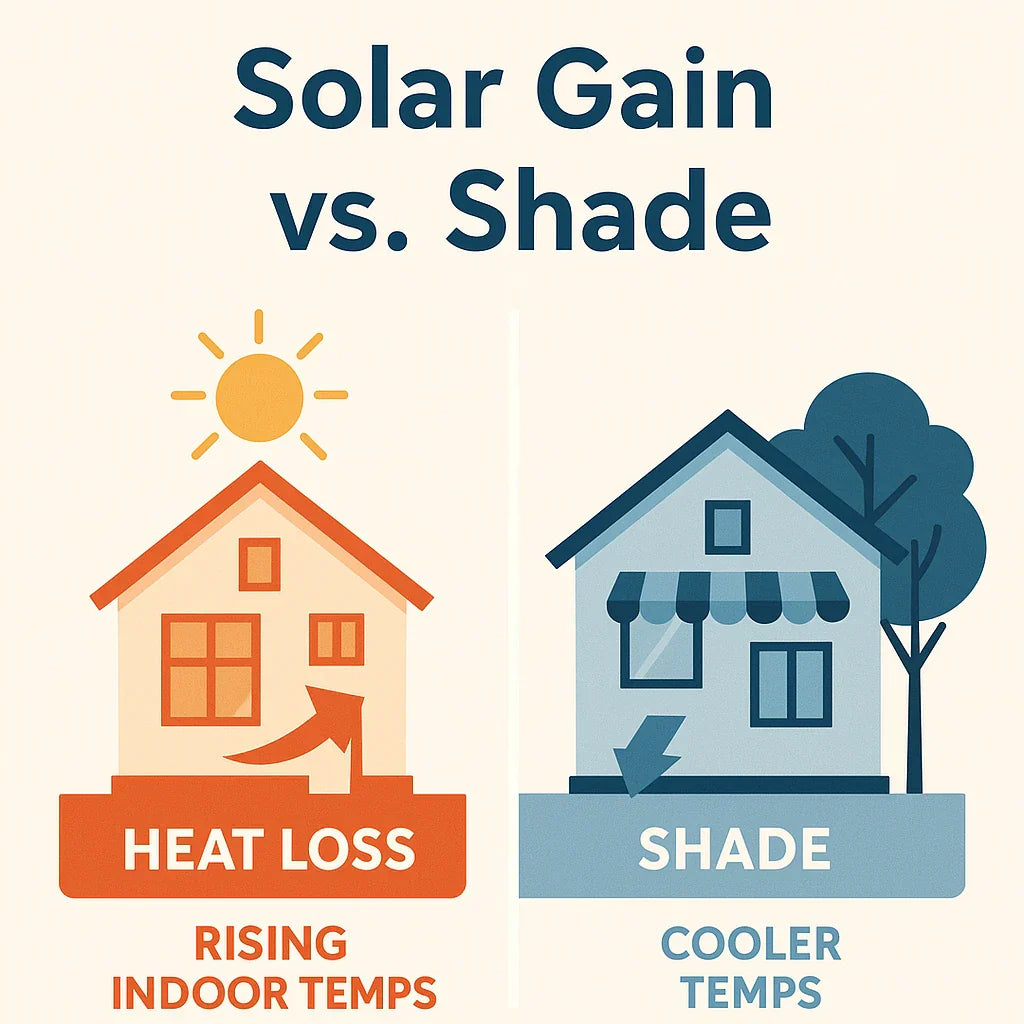When most homeowners think about HVAC sizing, they picture square footage, ceiling height, and insulation levels. But there’s another factor that makes a massive difference in how your system performs: solar gain and shade.
The amount of sunlight your home absorbs—or blocks—directly affects heating and cooling loads. A west-facing room with large windows can be unbearable in summer if solar gain isn’t accounted for, while a shaded home surrounded by trees may require less cooling power.
If you want your HVAC system to be sized correctly, sunlight and shade must be part of the equation. Ignoring them leads to oversized or undersized equipment, higher bills, and uneven comfort.
For a refresher on the basics of HVAC sizing, check out the main guide: How to Size an HVAC System for Your Home. In this article, we’ll dive deeper into how solar gain and shade factor into the calculation—and why they’re often overlooked.
What Is Solar Gain and Why Does It Matter?
Solar gain is the heat your home absorbs from sunlight. It enters through windows, roofing materials, and even walls, raising indoor temperatures.
-
Summer: Solar gain increases cooling demand. Homes with large, unshaded windows—especially facing west—require larger AC capacity to stay comfortable.
-
Winter: Solar gain can reduce heating loads by naturally warming rooms on sunny days, but this benefit isn’t always reliable in colder or cloudier climates.
The U.S. Department of Energy notes that windows alone can account for up to 30% of heating and cooling energy use. Choosing the right glass and factoring in solar heat gain are critical to accurate HVAC sizing.
The Role of Shade in Reducing HVAC Loads
Shade acts as a natural defense against solar gain. Homes surrounded by mature trees or equipped with shading devices need less cooling power than those in direct sun.
Landscaping and Trees
Trees planted on the south and west sides of your home can reduce AC demand by blocking harsh afternoon sunlight.
Awnings and Exterior Shading
Exterior shades, overhangs, and awnings cut down on solar heat gain significantly. The DOE’s passive solar design guidance highlights how orientation and shading strategies can lower cooling loads without sacrificing natural light.
Window Orientation
-
West-facing: Highest solar gain in the late afternoon.
-
South-facing: Consistent sunlight, beneficial for winter heating but challenging in summer.
-
North-facing: Least solar gain, generally easier to manage.
How Solar Gain Affects HVAC Sizing
Cooling Load in Summer
Direct sunlight through windows or onto roofing materials can dramatically increase cooling loads. For example:
-
A west-facing room with large single-pane windows may need additional cooling capacity.
-
Homes without shade often require larger AC units to combat heat buildup.
The EPA confirms that energy-efficient windows and shading devices can significantly reduce cooling demand—sometimes enough to allow for a smaller HVAC system.
Heating Load in Winter
Solar gain works in the opposite direction during winter. South-facing windows can reduce heating needs on sunny days, sometimes warming a room without turning on the furnace.
However, this isn’t always reliable in colder climates with limited winter sun. The ASHRAE climate and solar heating standards stress that while passive solar heating can reduce demand, HVAC systems must still be sized to handle cloudy days and overnight heat loss.
Why Contractors Consider Solar Gain in Manual J
Solar gain and shading aren’t “extras”—they’re built into professional HVAC sizing.
Manual J Load Calculations
Manual J, the industry standard for HVAC sizing, factors in:
-
Window orientation and size.
-
Glass type and solar heat gain coefficient (SHGC).
-
Shading from trees, awnings, and overhangs.
-
Roofing materials and insulation.
The ACCA Manual J guidelines explain that ignoring solar gain results in oversized or undersized systems that cost more to run and wear out faster.
What Happens If Solar Gain and Shade Are Ignored?
-
Oversized systems: Contractors may oversize equipment “just in case,” leading to short cycling, poor humidity control, and higher energy bills.
-
Undersized systems: In homes with large windows and direct sun, ignoring solar gain may leave AC units struggling to keep up.
-
Uneven comfort: Rooms with more sun exposure become hot spots in summer, while shaded areas feel much cooler.
Best Practices for Homeowners
Upgrade to Energy-Efficient Windows
Low-emissivity (Low-E) glass reduces solar heat gain. According to the DOE, ENERGY STAR-certified windows can cut energy costs by 12% nationwide.
Add Exterior Shading
Trees, pergolas, awnings, or solar screens can reduce cooling loads by blocking direct sun before it enters the home.
Use Reflective Roofing and Insulation
Light-colored or reflective roofs reduce heat absorption, lowering cooling demand.
Always Request a Manual J Calculation
Make sure your contractor includes solar gain and shading in the load calculation. This ensures your HVAC system is sized for real-world conditions—not just square footage.
For more on how unique spaces affect HVAC design, see the next article: HVAC Sizing for Detached Garages, Workshops, and Tiny Homes.
Final Thoughts
Solar gain and shade are often overlooked, but they have a major impact on HVAC sizing. A home that bakes in the afternoon sun requires different capacity than one surrounded by mature trees.
Ignoring these factors means higher bills, uneven comfort, and equipment that doesn’t last. Factoring them into your HVAC design ensures year-round comfort, lower operating costs, and better long-term performance.
When it comes to HVAC sizing, the sun really does matter.
Alex Lane
Your Home Comfort Advocate







